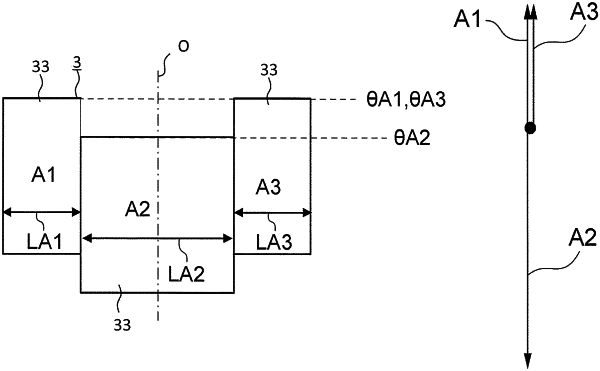| CPC H02K 29/03 (2013.01) [H02K 1/185 (2013.01); H02K 1/276 (2013.01); H02K 7/075 (2013.01); H02K 7/083 (2013.01); H02K 21/14 (2013.01); H02K 2201/06 (2013.01); H02K 2213/03 (2013.01)] | 13 Claims |

|
1. A rotating electric machine, comprising:
a stator;
a rotor provided to be opposed to the stator; and
a frame configured to hold the stator,
the rotor including:
a rotor core; and
a plurality of permanent magnets, which are provided in the rotor core, and are arranged in a circumferential direction of the rotor,
the rotor being divided into a plurality of blocks in an axial direction of the rotor,
the plurality of blocks including:
a skew-angle-increasing pair of blocks, which are a pair of blocks of the plurality of blocks that are adjacent to and shifted from each other in a first direction of the circumferential direction of the rotor from one end to another end of the rotor in the axial direction of the rotor; and
a skew-angle-decreasing pair of blocks, which are a pair of blocks of the plurality of blocks that are adjacent to and shifted from each other in a second direction, which is an opposite direction from the first direction, of the circumferential direction of the rotor from the one end to the another end of the rotor in the axial direction of the rotor,
the frame including:
a body portion, which is formed into a cylindrical shape, and is configured to hold the stator; and
a flange portion, which is provided at an end of the body portion in an axial direction of the body portion, and projects outward from the body portion in a radial direction of the body portion,
the body portion facing the stator has a thickness that changes from one end to another end of the body portion in the axial direction of the body portion,
wherein a shift angle of the skew-angle-increasing pair of blocks in the first direction is equal to a shift angle of the skew-angle-decreasing pair of blocks in the second direction,
wherein the plurality of blocks are three blocks,
wherein the three blocks include one skew-angle-increasing pair of blocks and one skew-angle-decreasing pair of blocks as the skew-angle-increasing pair of blocks and the skew-angle-decreasing pair of blocks from the one end to the another end of the rotor in the axial direction of the rotor,
wherein the plurality of blocks include a first block, a second block and a third block, which are arranged in the axial direction,
wherein LA1=LA3 and LA2=2×LA1 are satisfied, where LA1 represents a length of the first block in the axial direction, LA2 represents a length of the second block in the axial direction, and LA3 represents a length of the third block in the axial direction, and
wherein θA1=θA3 is satisfied, and θA2 is shifted by 30° from θA1 and θA3, where θA1 represents a shift angle of the first block with respect to a reference position of the plurality of blocks in the circumferential direction, θA2 represents a shift angle of the second block with respect to the reference position of the plurality of blocks in the circumferential direction, and θA3 represents a shift angle of the third block with respect to the reference position of the plurality of blocks in the circumferential direction,
wherein first electromagnetic excitation forces of sixth-ordered electric angle generated in the first block and second electromagnetic excitation forces of sixth-ordered electric angle generated in the second block have a phase difference of 180°, the second electromagnetic excitation forces of the second block and third electromagnetic excitation forces of sixth-ordered electric angle generated in the third block have a phase difference of 180°, such that a cumulative effect for the first block, the second block and the third block is a total electromagnetic excitation force of sixth-ordered electric angle equal to approximately zero electromagnetic excitation force.
|